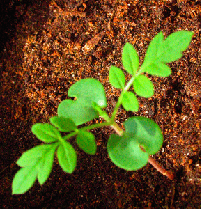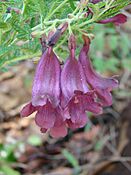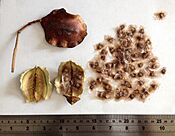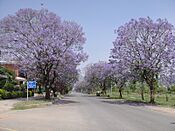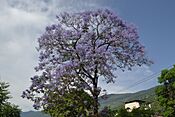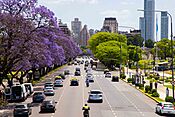Jacaranda facts for kids
Quick facts for kids Jacaranda |
|
|---|---|
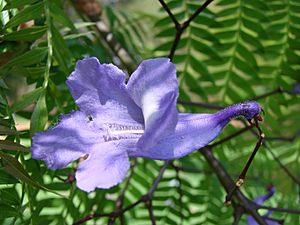 |
|
| A flower of Jacaranda mimosifolia | |
| Scientific classification |
|
| Kingdom: | Plantae |
| Clade: | Tracheophytes |
| Clade: | Angiosperms |
| Clade: | Eudicots |
| Clade: | Asterids |
| Order: | Lamiales |
| Family: | Bignoniaceae |
| Tribe: | Jacarandeae |
| Genus: | Jacaranda Juss. |
| Type species | |
| Jacaranda mimosifolia |
|
| Synonyms | |
|
|
Jacaranda is a group of 49 different kinds of flowering plants. These plants are often called Jacaranda too! They belong to the plant family called Bignoniaceae.
Jacaranda plants grow naturally in warm, tropical, and subtropical areas of the Americas. But people have planted them all over the world. One very popular type is the Jacaranda mimosifolia. You can find it growing wild in many places. These include Central America, the Caribbean, Spain, and Australia. It's even become famous in songs and stories.
Contents
What's in a Name?
The name Jacaranda comes from South America. It's from a language group called Tupi-Guarani. The word means "fragrant," which means it smells nice.
The name "jacaranda" was first written down in 1753. It was described as a tree whose wood was used for dyeing and medicine.
What Do Jacaranda Plants Look Like?
Jacaranda plants can be small shrubs or large trees. They can grow from about 65 to 100 feet (20 to 30 meters) tall.
Most Jacaranda species have special leaves. They are called bipinnate, which means they have many small leaflets arranged twice. Some types have simpler leaves.
The flowers are very noticeable. They grow in large clusters called panicles. Each flower has five petals. They are usually blue to purple-blue. A few types have white flowers.
After the flowers, a flat, oval fruit grows. This fruit is a capsule that holds many thin seeds.
How Are Jacaranda Plants Grouped?
Scientists divide the Jacaranda group into two main sections. These sections are called Monolobos and Dilobos. They are named based on tiny parts inside the flower called anthers.
The Monolobos section has 18 species. These are mostly found in western South America, Central America, Mexico, and the Caribbean.
The Dilobos section has 31 species. This group is mainly found in southeastern Brazil. Scientists think this might be the older group of Jacaranda plants. The wood of plants in these two sections also looks different.
Types of Jacaranda Plants
Here are some examples of the many Jacaranda species:
Sect. Monolobos
- Jacaranda acutifolia Bonpl.
- Jacaranda arborea Urb.
- Jacaranda brasiliana (Lam.) Pers.
- Jacaranda caerulea (L.) J.St.-Hil.
- Jacaranda caucana Pittier
- Jacaranda copaia (Aubl.) D.Don
- Jacaranda cowellii Britton & P.Wilson
- Jacaranda cuspidifolia Mart. ex DC.
- Jacaranda decurrens Cham.
- Jacaranda ekmanii Alain
- Jacaranda hesperia Dugand.
- Jacaranda mimosifolia D.Don
- Jacaranda obtusifolia Humboldt & Bonpl.
- Jacaranda orinocensis Sandw.
- Jacaranda poitaei Urb.
- Jacaranda praetermissa Sandw.
- Jacaranda selleana Urb.
- Jacaranda sparrei A.H.Gentry
Sect. Dilobos
- Jacaranda bracteata Bur. & K.Schum.
- Jacaranda bullata A.H.Gentry
- Jacaranda campinae A.Gentry & Morawetz
- Jacaranda carajasensis A.Gentry
- Jacaranda caroba (Vell.) DC.
- Jacaranda crassifolia Morawetz
- Jacaranda duckei Vattimo
- Jacaranda egleri Sandwith
- Jacaranda glabra (DC.) Bur. & K.Schum.
- Jacaranda grandifoliolata A.H.Gentry
- Jacaranda heterophylla M.M.Silva-Castro
- Jacaranda intricata A.Gentry & Morawetz
- Jacaranda irwinii A.Gentry
- Jacaranda jasminoides (Thunb.) Sandw.
- Jacaranda macrantha Cham.
- Jacaranda macrocarpa Bur. & K.Schum.
- Jacaranda micrantha Cham.
- Jacaranda montana Morawetz
- Jacaranda morii A.Gentry
- Jacaranda mutabilis Hassl.
- Jacaranda obovata Cham.
- Jacaranda oxyphylla Cham.
- Jacaranda paucifoliata Mart. ex DC.
- Jacaranda puberula Cham.
- Jacaranda racemosa Cham.
- Jacaranda rufa Manso
- Jacaranda rugosa A.H.Gentry
- Jacaranda simplicifolia K.Schum.
- Jacaranda subalpina Morawetz
- Jacaranda ulei Bur. & K.Schum.
Growing Jacaranda Plants
You can grow Jacaranda plants in a few ways. You can use seeds, cuttings, or a method called grafting. Plants grown from seeds take a long time to flower.
Jacaranda plants like soil that drains water well. They can handle dry periods and short times of frost or freezing temperatures.
These plants grow best in full sunshine and sandy soils. That's why you see so many of them in warm places. Older Jacaranda plants can survive in colder weather, down to about 19°F (-7°C). But they might not produce as many flowers. Younger plants are more delicate. They might not survive if temperatures drop below freezing.
How People Use Jacaranda
Many Jacaranda species are grown as ornamental plants. This means people plant them just because they are beautiful. They are especially loved for their amazing flower displays. The most common one is the blue jacaranda (Jacaranda mimosifolia).
Other types of Jacaranda are also important. For example, the Copaia (Jacaranda copaia) tree is valued for its timber. Its wood is used because it has a very long, straight trunk.
Gallery
-
Jacaranda mimosifolia trees in full bloom in Islamabad, Pakistan
-
Jacaranda trees in bloom in Buenos Aires, Argentina.
See also
 In Spanish: Jacarandá para niños
In Spanish: Jacarandá para niños


